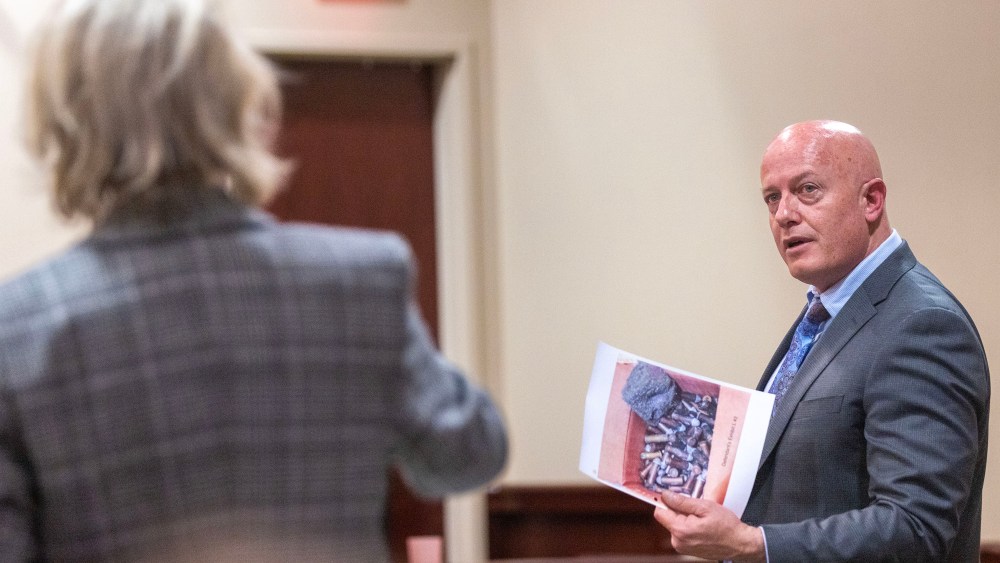‘Rust’ Trial Gets Heated as Defense Faults Incomplete Investigation
SANTA FE, N.M. — The “Rust” trial boiled over in hostile bickering between the prosecution and the defense on Wednesday, after the defense poked several holes in the Sheriff’s investigation.
Hannah Gutierrez Reed, the film’s armorer, is on trial for involuntary manslaughter in the October 2021 death of cinematographer Halyna Hutchins. The prosecution has argued that Gutierrez Reed unwittingly brought live ammunition on set.
Cpl. Alexandra Hancock, the lead investigator on the case for the Santa Fe County Sheriff’s Office, testified Wednesday that there is no “direct” evidence of that theory — only circumstantial evidence.
In his opening statement, prosecutor Jason Lewis argued that photos show that Gutierrez Reed had the live rounds on set as early as Oct. 10 — 11 days before the shooting — and failed to notice them.
But on cross-examination, Hancock agreed that she had “no idea” when the live rounds came on set.
“You have no idea if they appeared on Day 1 or Day 11?” asked defense attorney Jason Bowles.
“Correct,” Hancock said.
Bowles also questioned why the Sheriff’s Office did not do a more thorough investigation to determine where the live rounds came from. Among other things, detectives never talked to Joe Swanson, the dummy manufacturer whose initials — JS — appeared on the side of the dummy box found on set.
Hancock testified that the investigation was more focused on the shooting itself, rather than tracking down the source of the bullets.
“Really what’s important to law enforcement were the circumstances of what occurred that day, and the facts and the evidence of what occurred during the incident,” she said.
Moments later, Bowles asked if it was fair to say that she did not “fully investigate” the source of the live bullets.
“Yes,” Hancock answered.
The defense has blamed Seth Kenney, who supplied guns and ammunition to the production, for mixing live rounds with similar-looking dummy rounds. Bowles has argued that Kenney worked closely with investigators to shift the blame onto Gutierrez Reed.
Hancock testified that she received numerous calls from Kenney in the weeks after the shooting. Asked by Bowles if it felt like he was trying to influence the direction of the investigation, she said no.
“I don’t believe he was trying to steer me in any way,” Hancock said. “He was trying to be helpful in locating the source of the live ammunition.”
Bowles noted that Hancock never got DNA or fingerprint samples from Kenney, and never downloaded the contents of his phone. Hancock explained that she had taken samples from actor Alec Baldwin, Gutierrez Reed and two others because “they were on set” — and Kenney was not.
Bowles also faulted investigators for waiting more than a month after the shooting to search Kenney’s business, PDQ Arm and Prop, even though Kenney was one of the main suppliers of ammunition used on “Rust.”
When they did search the business, they did not find live rounds matching the ones found on set.
“There would have been time for Mr. Kenney, had he wanted to, to get rid of evidence if he wanted to?” Bowles asked.
“If he had wanted to,” Hancock replied.
On redirect, prosecutor Kari Morrissey noted that Hancock had followed up on information pointing to Kenney, but ultimately stopped pursuing the lead. When asked why, Hancock said that there was no evidence to support the idea that Kenney was the source of the live bullets.
In her police interrogation in December 2021, Gutierrez Reed said she had brought two boxes of rounds to the set, which she had filled with dummies which she kept in a bag in her car. She said the dummies were left over from an earlier film, “The Old Way,” and that Kenney had supplied them for use on that film.
Tempers flared in the midst of cross-examination of Hancock, as Bowles challenged the detective’s understanding of what Gutierrez Reed had said in her police interview. Hancock had testified that after the shooting, Gutierrez Reed said she emptied Baldwin’s Colt .45 onto a prop cart. Bowles argued that Hancock had misunderstood, and the defendant never said that.
Bowles and Morrissey exchanged a series of sharp remarks over that, ultimately prompting Judge Mary Marlowe Sommer to call a recess. The bickering went on for another 15 to 20 minutes, as the two sides fought over whether and how to replay an excerpt of the interrogation video.
The judge ultimately decided to move on, advising the jury that they could watch the video themselves once they begin deliberating.
Earlier in the trial, the defense faulted the responding officers for failing to prevent contamination of the scene. The Sheriff’s initial investigation has also been called into question by Robert Shilling, an investigator who was hired by the Santa Fe district attorney’s office. In an email last year, he termed the probe “reprehensible,” “unprofessional” and a “mess.”
David Halls, the first assistant director, is scheduled to testify on Thursday. He previously pleaded no contest in the case to a misdemeanor charge of negligent handling of a weapon. He was sentenced to six months of probation, and agreed to testify in other proceedings.
Baldwin, who was holding the gun that fired the fatal shot, is not scheduled to testify, as he will be facing his own involuntary manslaughter trial in July.

